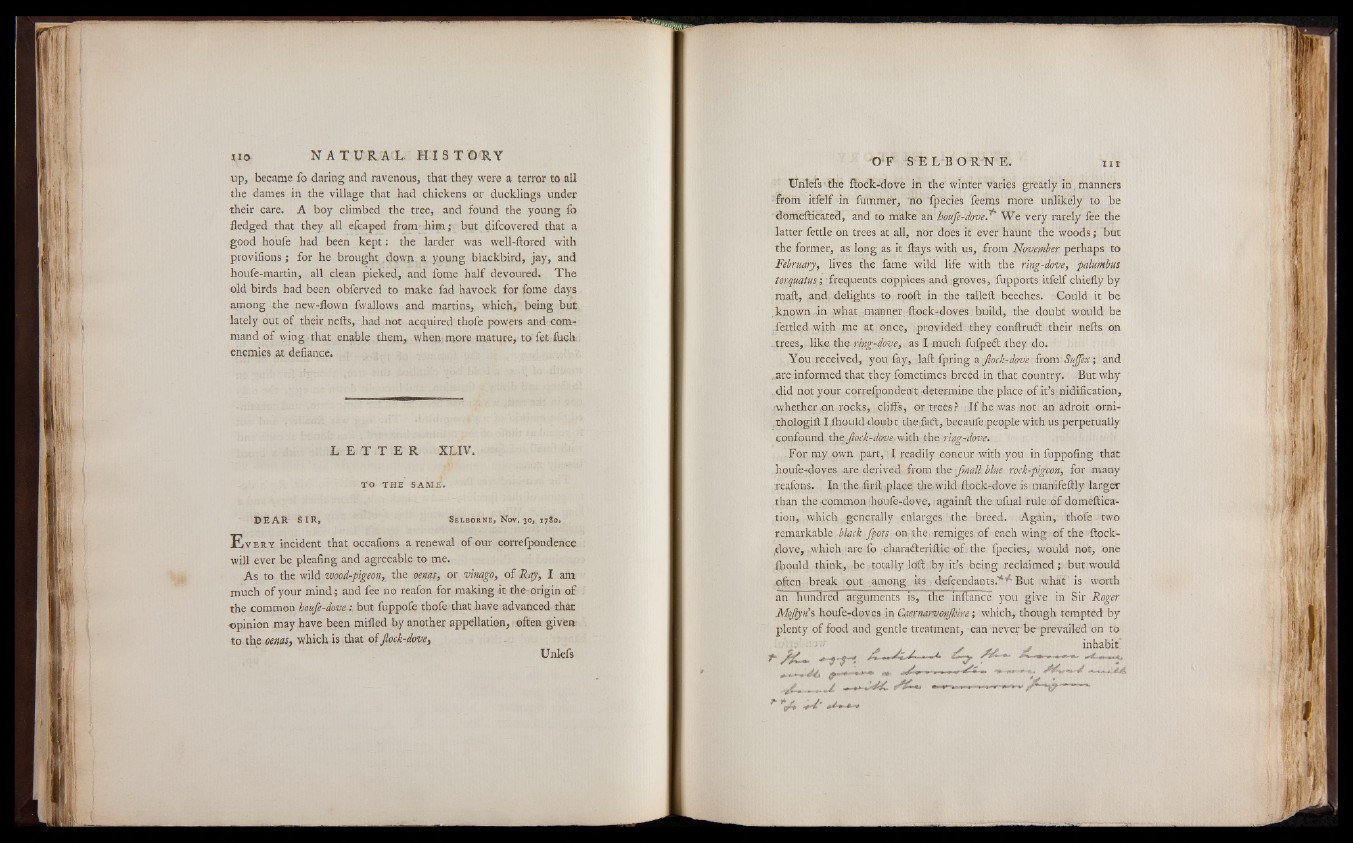
up, became fo daring and ravenous, that they were a terror to all
the dames in the village that had chickens or ducklings under
their care. A boy climbed the tree, and found the young fo
fledged that they all efeaped from-him; but difcovered that a
good houfe had been kep t: the larder was well-ftored with
provifions; for he brought down, a young blackbird, jay, and
houfe-martin, all clean picked, and fome half devoured. The
old birds had been obferved to make fad havock for fome days
among the new-flown fwallows and martins, which, being but
lately out of their nefts, had not acquired thofe powers and command
of wing that enable them, when-more mature, to fet fuch
enemies at defiance.
L E T T E R XLIV.
TO TH E S A M E .
B E A R SIR , Selborne, Nov. 30, i7*o.
E v e r y in c id e n t t h a t o c c a f io n s a r e n e w a l o f o u r c o r r e fp o n d e n c e
w i l l e v e r b e p l e a f in g a n d a g r e e a b l e t o m e .
As to the wild wood-pigeon,^ the oenas, or vinago, of Ray, I am
much of your mind-; and fee no reafon for making it the origin of
the common houfe-dove:. but fuppofe thofe that have advanced that
■ opinion may have been milled by another appellation, often given
to the oenas, which is that of jlock-dove,
Unlefs
Unlefs the flock-dove in the'winter Varies greatly in,manners
from itfelf in futfimer, no ‘fpecies Teems more unlikely to be
domefticated, and to make an h'oufe-doveWe very rarely fee the
latter fettle on trees at all, nor does it ever haunt the woods; but
the former, as long as it flays with us, -from November perhaps to
February, lives the fame wild life with the ring-dove, palumbus
torquatus; frequents coppices and groves, fupports. itfelf chiefly by
mail, and delights to rooft in the tailed beeches. Could it be
known in what manner flock-doves build, the doubt would be
fettled with' me at once, provided they conftrudt their nefts on
.trees,,, like, the rbngriove,,.as I much fufpedt.they. do.
You received, you fay, laffc fpring a Jlock-dove -from Sujfex; and
..areinformed that they fomecimes breed in that country. But why
did not your cor-refponden t determine the place.of it’s, nidification,
whether,on rocks, cliffs, or trees ? If he was not an adroit orni-
.thologift Ifhould doubt thefaft, becaufe.people with us perpetually
confound theJlock-dDve-w\th the ri^g^dove.
. For my own part, '! readily concur with you in fuppofing that
houfe-doyes are derived from the ;fmall:blue rock-pigeon, for many
reafons. In the firfbplacef the,.Wild ftodkdoye.is mandfeftly larger
than the common houfe-dove, ,againft the .ufual rule'of domeftica-
tion, which, generally enlarges 'the breed. Again, thofe two
remarkable black fpots on-the, remigestof each wing, of the flock-
dove, which -are fo characteriftic of the fpecies, would not, one
(fiould think, be totally loll by it’s bcir.g reclaimed; but would
often break out among its . defcendants.'*,t But what is-worth
an hundred arguments is, the inftance you give in Sir Roger
Mqfyn’s houfe-doyes in Caexnarvonjhire; which, though tempted by
plenty of food and gentle treatment, can never be prevailed on to
- -.j .. . inhabit
,11 « - i v-f" »—■ *■»"— - !•» —» j -111. . *
2**, . .. ./ —